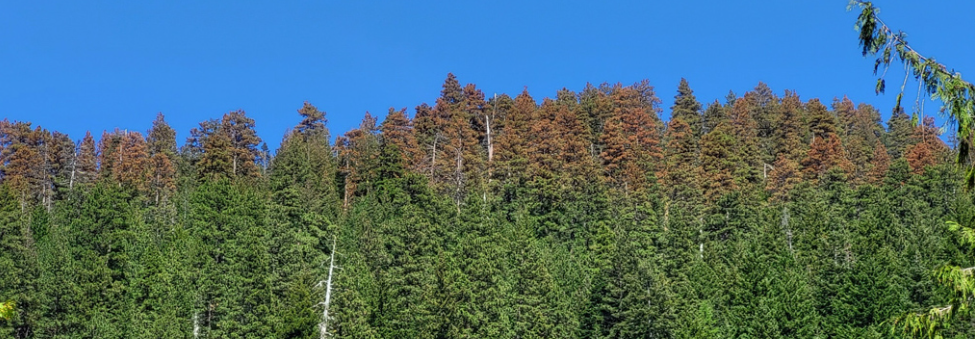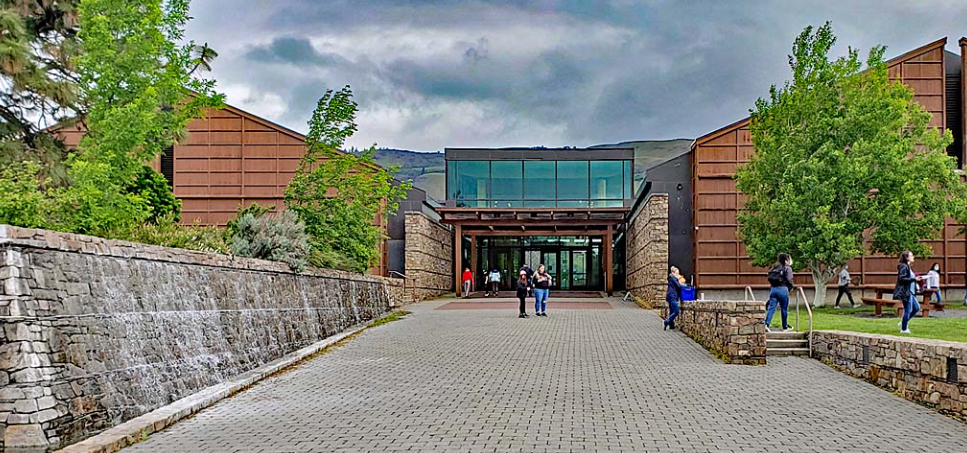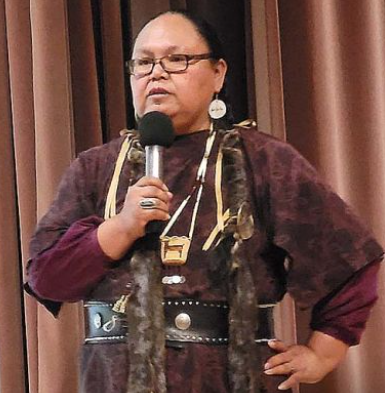Gorge Projected to get hotter, drier
Growing problem: Instead of regeneration, these treetops near Hood River are showing signs of decline. Photo: Jurgenhessphotography
Republished from Columbia Insight:
By Jim Drake
June 15, 2023 - “Climate change” is a problem. Not just the basic concept. Even the terminology is problematic.
So much so that Arnold Schwarzenegger recently recommended getting rid of the phrase altogether.
“As long as they keep talking about global climate change, they are not gonna go anywhere. ‘Cause no one gives a s— about that,” Schwarzenegger told CBS Sunday Morning. “Let’s rephrase this and communicate differently about it and really tell people—we’re talking about pollution. Pollution creates climate change, and pollution kills.
A May 20 conference in The Dalles, Ore., didn’t go quite that far. But in staging “Adapting to Climate Change in the Gorge” at the Columbia Gorge Discovery Center & Museum, organizers by and large succeeded in framing a sometimes abstract issue as a pressing concern at home.
Over the course of the day, a dozen or so experts and over 100 attendees discussed the effects of warming water temperatures on fish runs in the Columbia River, how climate change has already led to revisions in the Columbia River Gorge National Scenic Area management plan and changes in local wildlife populations and vegetation in the Gorge.
“We’ve been about action since 1976, and tackling a problem like climate change is analogous to removing invasive weeds,” said Pat Arnold of Friends of the White Salmon River. “We hope this conference helps in building a network for local action and uses diversity and environmental justice as the core values.”
Over the course of the day, four primary themes emerged.
The Gorge will get even hotter. And drier
The conference began with a discussion of current climate change impacts on the Cascade Range, and what to expect over the next half-century.
Dr. Oriana Chegwidden, a hydrologist and research scientist at CarbonPlan (a nonprofit that contributes science and data for climate action) specializing in civil and environmental engineering, said global temperature increases won’t spare the Gorge.
“Our data shows that the Pacific Northwest will get warmer, likely a 5-10 degree increase, and wetter,” she said. “By 2080, snow accumulation will be gone. A lot of places won’t have snow anymore. Precipitation that used to fall as snow will fall as rain.”
Building issues: Adapting to Climate Change in the Gorge drew over 100 attendees to the Columbia Gorge Discovery Center & Museum in The Dalles. Photo: Jurgenhessphotography
Building issues: Adapting to Climate Change in the Gorge drew over 100 attendees to the Columbia Gorge Discovery Center & Museum in The Dalles. Photo: Jurgenhessphotography
The lack of snowpack will impact everything from salmon runs to energy production to agriculture in a region that relies on hydroelectricity from dams.
“Snow is a reservoir of water that we’ve relied on for providing cold water for fish throughout the year,” said Chegwidden. “And, of course, the U.S and Canada rely on snow as a source of water for hydroelectric power generation.”
Chegwidden said as snowpack dwindles, changes will be reflected in wildlife habitats, recreational uses, stream temperatures and increased fire risks.
Cold water refuges will take on greater importance
As water temperatures increase, cool spots in rivers and streams—often created at the confluence of mountain streams and the main stem of the Columbia River—are increasingly used by migrating fish.
Scientists call these areas of naturally occurring thermal relief “cold water refuges” or CWR. They’re sometimes referred to as “thermal refuges,” “thermal sanctuaries” or simply “refugia,” but each term describes the same thing.
Several speakers addressed the need to rehabilitate Gorge streambeds and riverbanks to provide a temperature-controlled waterway necessary for salmon survival.
“We know 60,000-70,000 steelhead will use cold water refuges in August and September,” said biologist Bill Weiler, adding that tree-planting on the Sandy River near Portland has helped the salmon population there. “Creating cold water refuges increases survival rate by 10 times.”
“Climate change is yet another factor in how fish populations are affected,” said stream ecologist Pat Connolly. “The question of survival depends on how we take care of the watersheds, and that includes the Pacific Ocean. Will we be able to fix enough of the stressors in their environment?”
Orchardists will stop burning old trees
“An orchard has a lifespan—about 25 years,” according to Dr. Ashley Thompson, of the Mid-Columbia Ag Research Station, an OSU Extension service that offers guidance on orchard management.
Orchardists are constantly pulling out trees at the end of their lifespan and replanting with new stock. Thompson is working with orchardists in the Gorge to find alternatives to making burn piles of trees and other orchard debris that needs to be disposed of.
Oregon’s Hood River Valley. Photo: Oregon Taste
“Burning is a cheap way for disposal, but trying to mitigate and adapt to climate change is pressuring us to reduce the amount of CO2 back into the air,” said Thompson. “We’re looking at ways of keeping the carbon sequestered.”
One procedure is called “orchard mulching.”
“Orchard mulching is a heavy-duty, wood-chipping type machine that uses diesel fuel, but it’s a way of returning carbon to the soil,” said Thompson. “There’s even a mulch-in-place machine, which travels along a path and deposits the material as it goes along. But right now, that’s an expensive option.”
Another experimental method is the creation of “biochar.”
Using extremely high temperatures, orchard waste material undergoes pyrolysis (decomposition brought about by high temperatures) to form a charcoal-like material that sequesters carbon and may hold more nutrients and water in the soil.
But some studies indicate soil chemistry may be changed by the creation of biochar and nutrient uptake by some crops may be affected.
“Right now, the EPA is saying biochar creation is in itself a point source of pollution,” said Thompson. “And it’s mega-expensive. A biochar machine is not in the budget of a single-family orchard. But I’ve always wondered about the possibility of farms coming together to buy one.”
Environmental justice will be front and center
A session titled “Climate Change and Environmental Equity” presented perspectives from both the Yakama Nation and the Gorge’s Latino community.
Historic concerns: Elaine Harvey addresses the conference. Photo: Jurgenhessphotography
Elaine Harvey, a Yakama tribal member and environmental coordinator for the Yakama Nation Fisheries, told the audience her tribe has been aware of climate change effects for decades, because tribal members actively collect food in ways that date back before encountering the Lewis and Clark expedition in 1805.
Historic concerns: Elaine Harvey addresses the conference. Photo: Jurgenhessphotography
“The fishing, root and berry harvest seasons are no longer consistent and are a reflection of a changing climate,” she said, reading a statement from tribal members.
But the real message was in Harvey’s voice, which reflected a passionate connection to the land.
“Climate change is happening already. We are there every day. I’m speaking on behalf of the species, the water and the land. We’ve gotta protect these things for the unborn,” said Harvey.
Harvey said the Yakama tribe’s Climate Adaptation Plan from 2021 focuses on tracking fish, water quality issues, and huckleberry strategies and works to protect treaty-reserved species.
“We really need to work with the Washington Department of Natural Resources to bring beaver back to the watershed areas,” said Harvey.
Ubaldo Hernandez, an activist in the Latino community and outreach coordinator for Columbia Riverkeeper, took on the topic of bringing social justice in line with the movement to adapt to environmental changes. Having grown up in an activist family in Mexico City, Hernandez said communities need to be open and welcoming to the views of people of color to prevent inequality.
“We want to be part of the discussion and have a place to speak up,” he said.
Speaking about farmworker issues, including the risks of farmworkers to pesticide use and not having access to forums to voice concerns, Ubaldo said his work at Columbia Riverkeeper has demonstrated how important the river is to all of us.
“But we have to talk about social justice when it comes to climate change, and we have to tell you how we feel about this from the perspective of the farm worker community,” he said. “We can’t just be told that we have to be concerned. In order to change, we need to have a conversation.”



